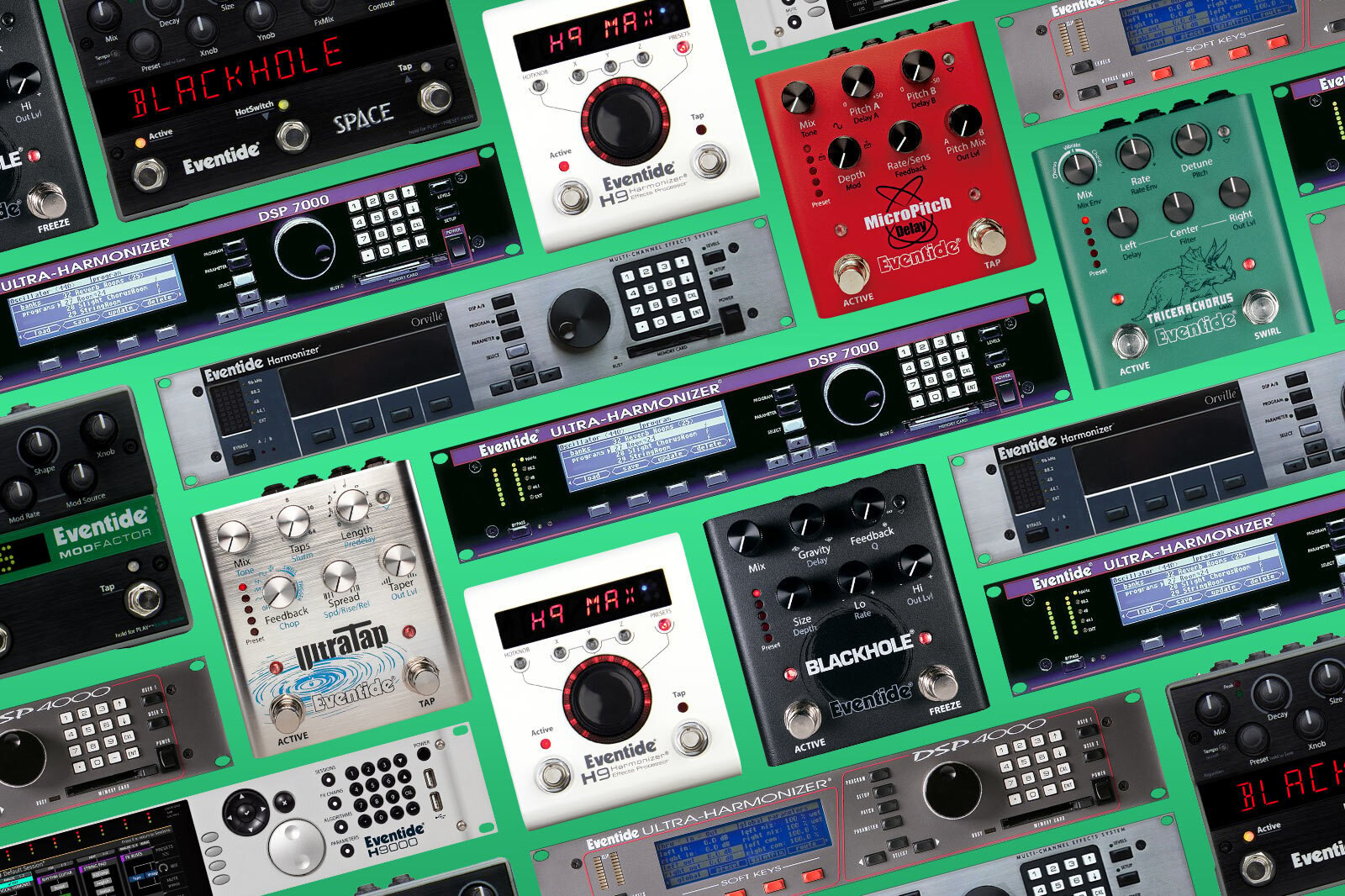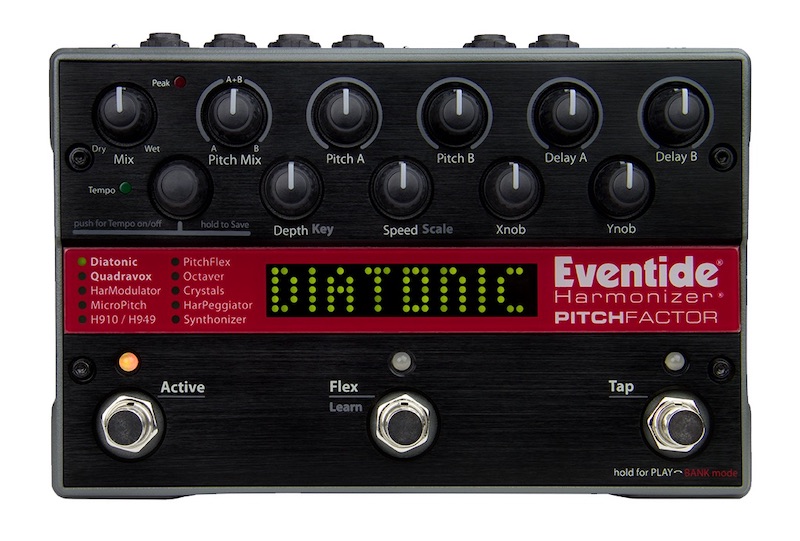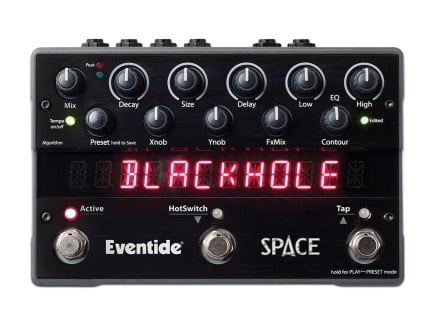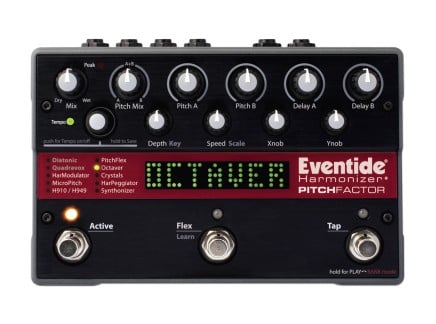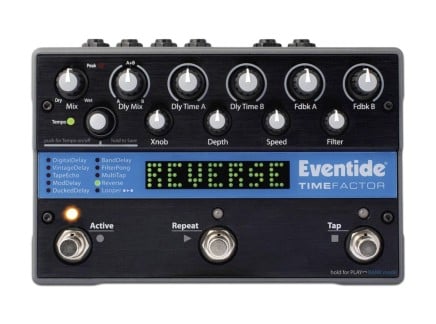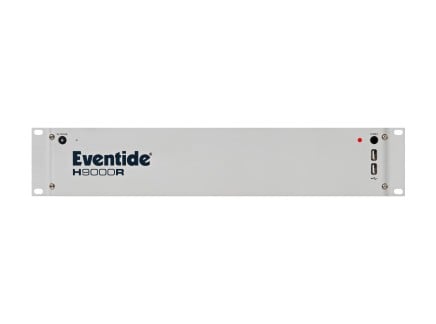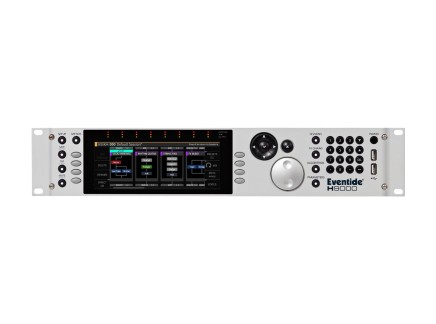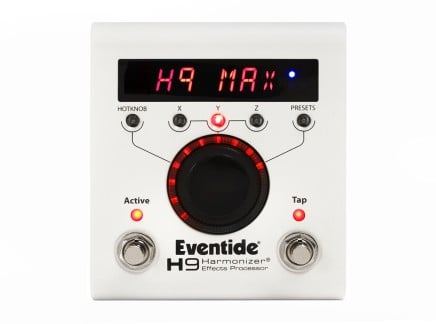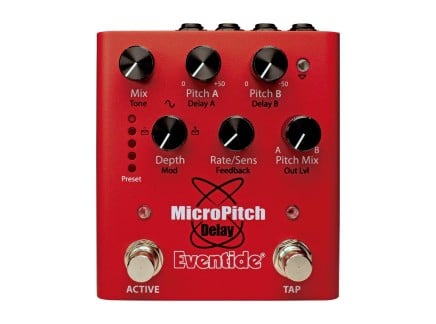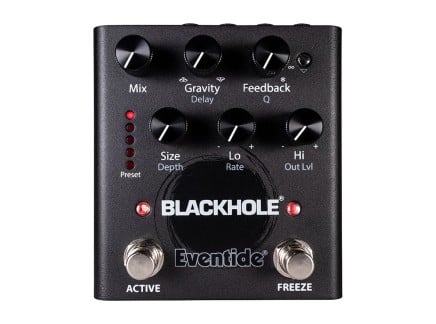In a recent article, we took a look back at the first two decades of groundbreaking innovations from an industry leader in advanced audio effect processing: Eventide. From the introduction of the DDL1745 (the world's first rackmount digital delay) in 1971 through pitch shifters/harmonizers, phasers, flangers, all the way to 1988's H3000S Harmonizer (a full-fledged multi-effects processor with preset memory), their ingenuity was uncompromising and unparalleled. Check out A Brief History of Eventide, Pt. 1 to get up to speed—and to prime you for what happened next. We're picking up here right where we left off in our last article.
By 1990, Eventide was primed to enter a new technological era. They had already gained a reputation of pushing the limits beyond what was previously possible: from the very beginning, their products were often "the first" in one or another category. While this was certainly helpful for gaining recognition early in their career, setting the bar that high can also make it difficult to jump over.
However, Eventide developed and maintained a clever growth strategy, which led them to create many more devices destined to become "iconic". Instead of casting a wider net into different realms of audio technology, Eventide went even deeper into digital signal processing, enhancing and perfecting their signature multi-effects devices, and experimenting with plenty of clever ideas for how to bring those tools to multiple markets.
The 1990s: The Many Faces of the Harmonizer
Picking up right where they left off, the 1990s turned out to be the era of 'The Harmonizer'. With each new release, Eventide continued developing and polishing the Harmonizer concept to a point where, for many people, the very name "Eventide" became synonymous with harmonizers and high-quality DSP effects.
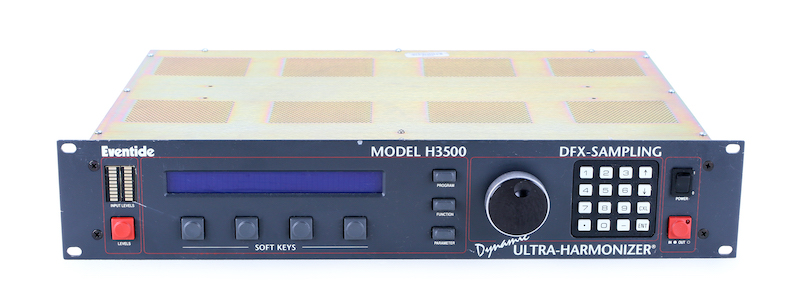
In the very first year of the new decade, 1990, Eventide rolled out the H3000B Harmonizer, a direct outgrowth from the original H3000. The added features included some new algorithms and presets specifically designed for use in broadcasting. The next step in the evolution of this series came four years later, with the simultaneous release of the H3000B+, H3000B/LT, H3000D/SX, and H3000D/SE. The new line of Harmonizers was packed with hundreds of effects, including complex reverbs and pitch-change algorithms—and the H3000B+ additionally included a brand new Timesqueeze algorithm and dedicated hardware for controlling the speed of tape machines (whoa). Several other variants of the H3000 were also released, each with a slightly different feature set than the last.
This segmented product line strategy is something that Eventide would continue to explore for years to come—tailoring and fine-tuning essentially the same core device and DSP to different markets and user needs. This allowed customers to select a unit based on a specific hardware compatibility, or other features such as a specific set of algorithms…or to decide that certain features were unnecessary for their purposes, allowing them to spend less on a purchase. This is quite a brilliant approach, allowing them to reach everyone from recording studios, broadcasters, guitarists, and more with slight variations on the same core product. As we go on, we'll see that this is fairly similar to Eventide's product development approach to this very day.
In 1994, Eventide introduced another set of groundbreaking products: the DSP4000 Ultra-Harmonizer and DSP4000B Production Ultra-Harmonizer—a new line of programmable digital multi-effects processors that were far more powerful than any of the brand's previous models. These units were fully equipped with digital and analog I/O, an extended preset storage system with swappable memory cards, a large LCD display for easier navigation, and the then-novel concept of a Patch Editor (aka Algorithm Construction Kit), a built-in system which allowed used to design their own effect algorithms from a very low level. With ACK, The possibilities were endless—the effects library contained 90 effects modules, and up to 40 of these modules could be strung together for a single preset! The process was similar to patching a modular synthesizer or connecting guitar pedals together, albeit virtually—and in fact, this functionality led to the creation of some of Eventide's most treasured algorithms altogether.
In 1995, Following the success of the DSP4000, Eventide unveiled the GTR4000 Ultra-Harmonizer in response to active demand from one of the brand's fastest-growing customer bases—guitar players. The GTR4000 included artist-curated preset lists, and a "virtual pedalboard" that could host up to 6 customized effects with an on/off switch and real-time parameter control via an external MIDI foot controller.
All of the three Ultra-Harmonizers could be upgraded with three dedicated sampler cards (offering up to 22, 87, or 174 seconds of sampling time, respectively). Additionally, the library on any of the models could also be expanded via PCMCIA cards, and as such, any of the DSP4000 models could be customized to the user's needs.
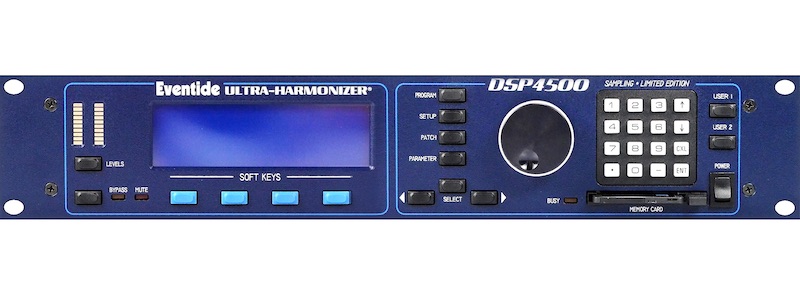
Then, in 1998, Eventide released a brand new model, the DSP4500: an enhanced model that boasted the features and presets from all three previous Ultra-Harmonizer models and then some. For one, the DSP4500 contained over 1000 presets, including all of the previously available presets, plus the new "Alchemy 101" library with effects designed by Scott Gilfix (also available on a PCMCIA card for previous models). The new Ultra-Harmonizer also sported an internal 87-second sampler card, making the feature usable right out of the box without the need for an expansion card.
The Ultra-Harmonizer series effects were undoubtedly top-of-the-line sound processors used and desired by many artists and audio professionals, and they set the standard for years to come. Many of the algorithms designed for these models are still more than relevant today—in fact, DSP4000 was the birthplace of the famed Blackhole reverb algorithm, the basis for several modern-day Eventide pedals and plugins (thanks to Drew Schlesinger for designing this amazing algorithm!).
However, up until the late '90s, all multi-effect processors Eventide produced functioned at most in stereo, and as digital processors were rapidly becoming more powerful, the time had come for the company to enter the realm of multi-channel audio. Thus, in 1999 Eventide unveiled their first multi-channel effects system—Orville.
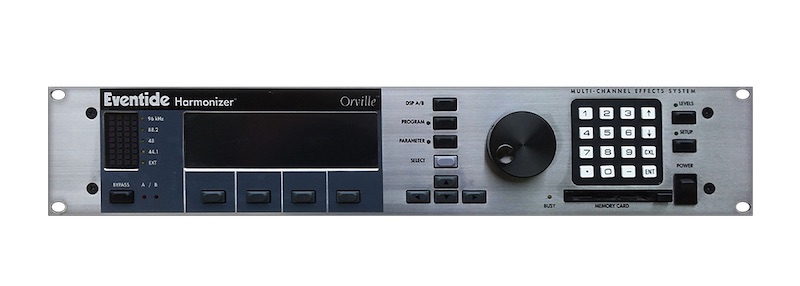
Orville was equipped with four inputs and four outputs and possessed a processor powerful enough to run a complex 4-channel surround sound reverb algorithm and much more. Another new addition for Orville was the UltraShifter algorithm, designed to preserve the formants during the pitch-shifting process for a stunningly natural sonic quality. The EVE/NET control system was another novel development accompanying Orville, introduced by the company as a remote network-based controller for the rack effects processors. By all means, the release of Orville was a defining moment that set the direction for even the most recent top-shelf Eventide processors.
While we are not focusing on Eventide's line of utility processors throughout this article, for the sake of complete representation of the company's output, we still would like to add some brief mentions. Two more products extending the Broadcast (Obscenity) Delay range were introduced by Eventide in the '90s: BD1020 (1995) and BD500 (1996). The BD1020 was intended to be a more compact and cost-effective variant in the broadcast delay series. BD500, on the other hand, was packed with a wealth of new options such as an extended Dump feature, which now allowed to splice out unwanted material anywhere from one second, and up to the length of the entire delay time, and a SNEEZE function which made it possible for the person on the air to sneeze, cough, make short comments without being heard by the audience.
The 2000s: Transcending Formats
Orville was an extraordinary (and yet again, groundbreaking) piece of audio technology—and with that came a high price tag. Thus, Eventide's first product of the new millennium was Orville/R—a price-reduced alternative to Orville which possessed all of the features of the original unit, minus the front screen and controls. Interestingly, although the concept of multi-channel multi-effect units was taken much further by the company in the next years, the name "Orville" didn't stick, and Orville/R was the last time it was used.
In the same year (2001), Eventide also presented DSP7000 and DSP7500, which continued the legacy of the DSP4000, albeit with four times the processing power. In the tradition of Eventide, the difference between the two models was primarily the extended amount of presets, and longer sampling time of the DSP7500. Then, in 2006 Eventide rolled out an even more beefed-up stereo rackmount effects processor—the DSP7600, which boasted a library of 1100 effect algorithms, and a nearly 3-minute built-in sampler. Whoa.
We should interject some perspective here: the 2000s were quite an interesting and peculiar period in the history of recorded music. With the increased spread of personal computers, peer-to-peer music sharing, the significant price reduction in complex technology, and the increasing power of such technologies, the world started an exciting, sometimes messy, and for some, a painful transition from large-scale recording studios to smaller project environments— all the way to compact home-based setups. And although this trend can be traced all the way back to back to the Portastudios of the '80s—and to some extent even earlier to composers experimenting with portable tape recorders—it was in the 2000s that this process started heavily intensifying, and many in the music tech industry felt that it was a point of no return.
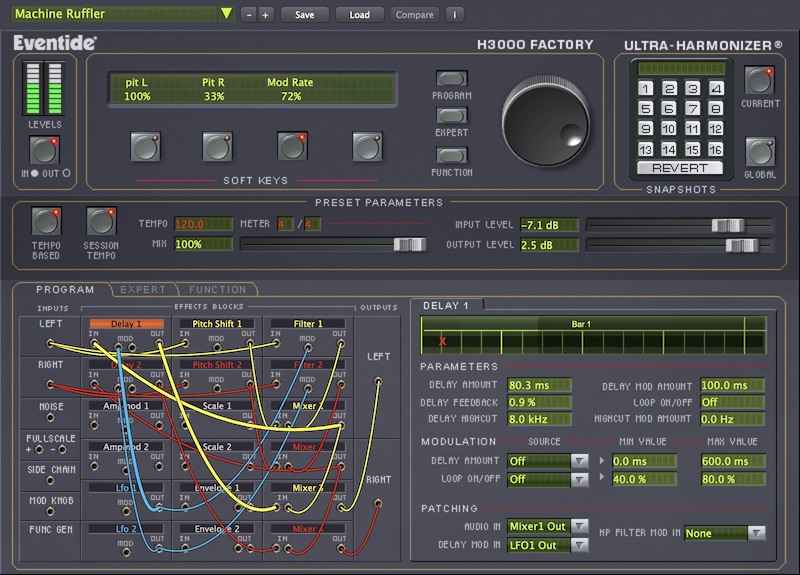
Various software programs and plug-ins were quickly becoming the dominant tools for recording engineers and music makers. Since Eventide had established and maintained its position at the forefront of digital audio and DSP algorithms for three decades before that, it doesn't feel suitable to say that the company caught the wind of change—instead, they were among those that caused that wind. And while a lesser company might have seen the shift to computer-based recording and processing as a threat to their hardware-centric business, Eventide instead saw it as an opportunity.
As such, in 2005 Eventide released their first software plug-in suite: Anthology TDM. The collection included software recreations of the Clockworks era devices, as well as H3000 Band Delays, and H3000 Factory based on the legendary unit, as well as two algorithms extracted from the Orville system, Reverb and Octavox. These plug-ins are absolutely remarkable, and are still available to this day—in fact, many of us at Perfect Circuit heavily rely on these plug-ins for our own personal music-making.
2005 also saw the release of Eventide's H8000FW—a reimagined multi-channel effects processor surpassing the Orville both in power, content, I/O, and features. H8000FW came with a whopping collection of 1600 preset algorithms suitable for both music and post-production applications, including 5.1 surround sound delays and reverbs. One of its most outstanding and groundbreaking features, though, was that the multi-effect processor doubled as a 24-bit audio interface for Mac and PC, allowing simultaneous recording and processing via its eight analog inputs and outputs.
If you haven't noticed yet, up until this point Eventide's products were mostly rackmount units geared towards work in the studio or in some pretty serious live rigs. This format certainly made sense since the multi-effects effects processors were extremely powerful and feature-dense…however, they took notice that certain algorithms were significantly more popular than others, and as such, they decided to make several of them available in the form of guitar pedals—presenting their prized studio-quality effects in an unprecedented format far more relevant to performing musicians. Thus, in 2007 the Factor Series of pedals was born.
This collection, still available as of the publishing of this article, is comprised of four extremely versatile stompboxes covering a wide range of effects: PitchFactor provides pitch shifting, harmonizing, and pitch-shifted delays, with TimeFactor for advanced dual delay and looping, ModFactor for modulation-type effects, and Space for everything from room-like to impossibly vast reverbs. Encompassing the sound and ethos of Eventide's classic processors and recent hits, these pedals support mono or stereo operation and switchable line/instrument-level inputs and outputs—all in all, making them perfect tools for guitarists, keyboardists, producers, and basically every other type of musician. They are densely populated with control knobs to provide the users with access to a wide range of parameters—and additionally, the pedals each feature 5-pin MIDI I/O ports on the side, allowing the parameters to be accessed remotely via a separate controller (altogether, making for an unprecedented level of hands-on control of Eventide effects). The Factor Series pedals have been tremendously successful, and even these have reached an iconic status…making it clear to Eventide that this direction would be well worth further exploration. With their next product, they followed through with extraordinary depth.
The 2010s: From H9 to H9000
In 2013, a brand new stompbox pedal was introduced by Eventide bearing a similar naming scheme as their grandiose rackmount multi-effects units: the H9. Indeed, it was immediately clear that H9 was no ordinary guitar pedal—not in how it looked, not in how it worked, not in how it sounded. With its instantly-recognizable white enclosure, giant LED-backlit rotary encoder, five tiny buttons, LCD screen, and two footswitches, the H9 embodied a certain futuristic quality, and behind that slick new look was an insanely powerful multi-effects processor.
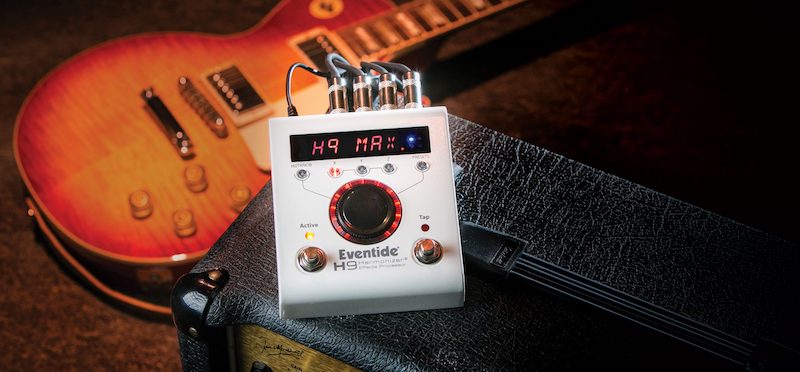
Essentially, H9 can be seen as a very compact Harmonizer-like processor with a rich collection of algorithms—many of them directly borrowed from famous algorithms in its Harmonizer-series predecessors. This meant that in an instant, the pedal could switch from being a lush reverb to a gritty distortion to a delay to a pitch-shifter, and more: Black Holes and Crystals and beyond. Upon release, two versions were available: H9 Max, and H9 Core. While these were exactly identical in terms of hardware, the Max version came with the complete collection of algorithms, while the Core contained a trimmed-down selection (although more could be purchased separately as needed). Like many members of the Harmonizer family, it was also expandable—in this case, meaning that several pedals (up to five) can be connected to the same user account, sharing the available selection of algorithms. Thus, one could buy a single H9 Max, and complement it with a few H9 Cores. While programming and control can be done directly on the pedal, Eventide developed a companion H9 Control application for IOS that provides a more extended and easy-to-use interface. Since its release, the pedal quickly found its way to the setups of countless artists and remains a mainstay for many to this day—though the H9 Max is the only version still presently available.
In the 2010s, Eventide also made a significant advancement in the range of their range of audio software. This included porting some of the H9 algorithms to the plug-in format, as well as the development of a brand new approach to signal processing described by the company as Structural Effects, first with the release of the Physion processor in 2017, and more recently with the SplitEQ plug-in. The Structural Effects series is based on a novel concept of splitting the sound's tonal and transient parts and making them available for separate processing. This manifests in rather nuanced sound sculpting opportunities ranging from amazingly natural pitch-shifting all the way to more extreme and bizarre effects.
Throughout the 2010s, Eventide managed to produce iconic effects pedals and trailblazing plug-in concepts, but in 2017 they also brought into existence the magnificent H9000—the most recent member of their flagship Harmonizer series.
Now more powerful and feature-packed than any of the previous models, H9000 comes at an uncommonly high price tag for an effect processor—but it is, no doubt, the most sophisticated, luxurious, and uncompromising piece of commercially-available audio processing hardware available. With 16 DSP chips driven by four quad-core ARM processors, 8x8 analog I/O, digital I/O, audio, MIDI interface functionality, plus—for the first time ever—full support for popular networking protocols like DANTE, MADI, and AVB, the H9000 is ready to take on sonic restructuring at any level complexity, including complex surround reverbs and delays.
Expectedly, the multi-effects processor also comes loaded with thousands of algorithms ranging from Eventide's classics to absolutely new designs, and like its predecessors, it allows users to create their own algorithms from raw elements (via computer editor)—thus it is hard to imagine anyone ever being able to explore all of the sonic possibilities of the H9000. As such, the machine is likely to provide inspiration to music makers and sonic explorers for decades. Without any reservations, it seems apt to suggest that H9000 is a dream device for sound design, post-production applications, large-scale live situations, broadcasting, theater, and any other environment that can benefit from a high-performance multi-channel sound processor.
Worth noting is that, similar to the Orville and Orville/R before it, the H9000 is also available as H9000R, which foregoes the dedicated user interface in favor of remote control via the Mac and PC-compatible Emote software. This editor software for the H9000 and H9000R makes it much simpler to manage complex tasks on the H9000 (especially when constructing your own algorithms), and is critical for making use of the H9000R.
Always Looking Forward
At last, we have finally covered around forty years of Eventide's output in the world of sound processing, filled with groundbreaking technologies, clever ideas, and beautiful designs. At this point, it is perfectly clear that Eventide is here to stay, and that the company still has a lot to offer.
We haven't covered absolutely everything here: for instance, some of our favorite recent developments include the EuroDDL, a real Eventide delay in Eurorack modular synthesizer format, replete with CV and Gate I/O—truly one of the best delays available for modular synths today. Additionally, the recent release of the dot9 effect pedal brings some of Eventide's most popular algorithms into dedicated, algorithm-specific devices for the first time. The Blackhole reverb, Microshift, Tricerachorus, and Ultratap each provide a hands-on experience for classic Eventide effects previously only available in multi-purpose devices or software form. We've been pleasantly surprised to see what adding a thoroughly thought-out user interface to these processors has meant: musicians in some cases are now able to more deeply and intentionally interact with these effects than ever before.
While we can't know exactly what the company has planned for us in the future, based on what the brand has been producing previously, their strong vision, and sharpened senses for the needs and wants of the audio industry, we can rest assured that it will be quite exciting. Will we see new Eurorack modules? New effect pedals? Yet another revolution in the state of audio processing altogether? We don't know what will come next, but we're keeping our eyes and ears eagerly open to whatever Eventide has to offer.
(The images used in this article were sourced from Eventide's online documentation of their legacy products. Definitely check out this resource—it is a remarkably thorough source of inspiration, historical context, and entertainment for all us effect processing nerds!)

